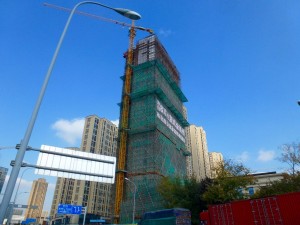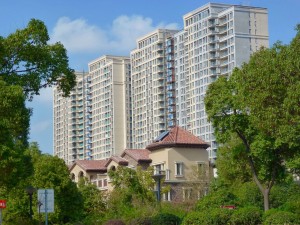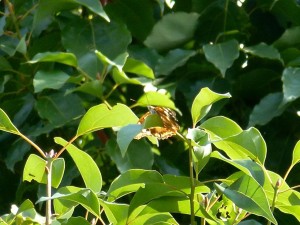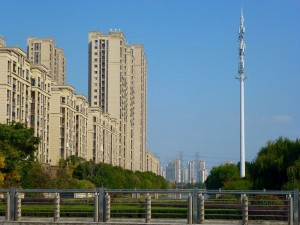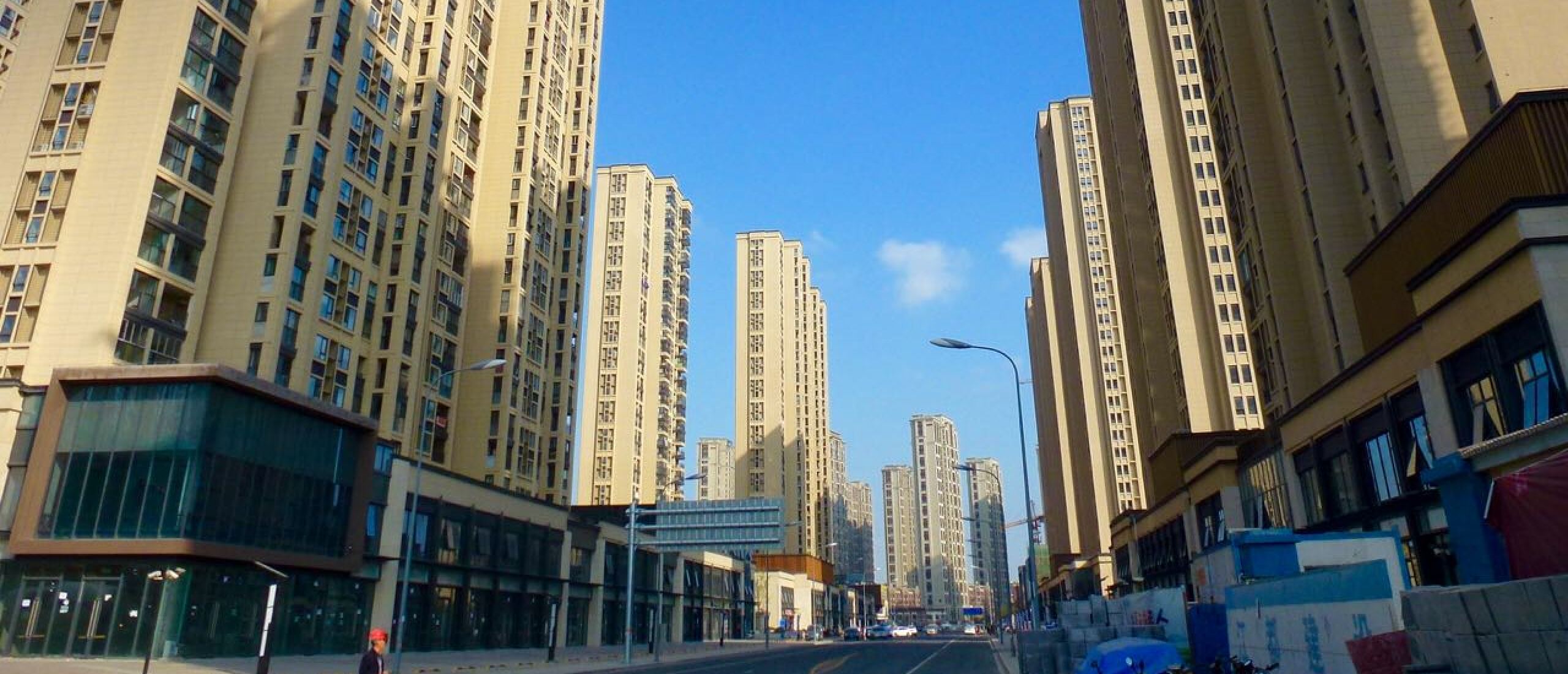
The Emperors of Yinshan Lake Following my frightening experience of nearly being hit by a car yesterday, I made my way with some trepidation to the subway station, keeping a wary eye open for any unexpected vehicle movements. A short journey of just five stops took me to Yinshan Hu station, and I emerged into one of the new residential areas that China seems to be able to erect in the space of just a few months. Huge blocks of flats were going up almost visibly, and the pounding of pile-drivers and the clanking of cranes could be heard in all directions.
A short walk brought me to the shores of Yinshan Lake, which my map calls Yinshan River, but it looked more like a lake to me. First impressions indicated that it would be sterile in terms of aquatic birds, but I immediately spotted a Great Crested Grebe, a new species for my Chinese list. It turned out that there were perhaps 50 of these birds on the lake, along with several Little Grebes, Moorhens and two rafts of Mallard which, given the Chinese human population’s liking for eating duck, were wisely floating well out on the water.
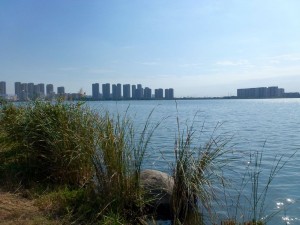 Yinshan Lake with apartment blocks beyond it
Yinshan Lake with apartment blocks beyond it
It was not long before the characteristic squeaky call of one of my favourite East Asian birds drew my attention to a resplendent male Daurian Redstart, a common winter visitor from Russia (Dauria is an old name for Ussuriland, in the Russian Far East). These lovely, confiding birds can be found in any small patch of greenery, even in the city.
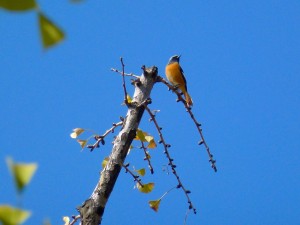 A splendid male Daurian Redstart atop a Gingko tree
A splendid male Daurian Redstart atop a Gingko tree
Olive-backed Pipits were much in evidence too, their nasal, buzzy calls giving them away. These birds used to be known as Indian Tree Pipits, and they are also relatively common in any parkland area. Chinese Bulbuls were also very conspicuous. The local form here is now known as the White-vented Bulbul, and there is talk of making this species the City Bird of Shanghai, as it endemic to the Shanghai/Suzhou/Hangzhou area.
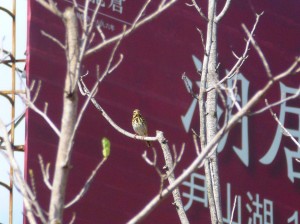 An Olive-backed Pipit against a vast billboard
An Olive-backed Pipit against a vast billboard
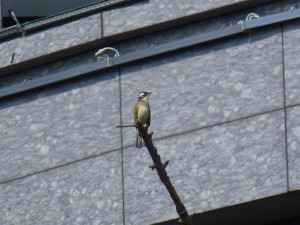 The White-vented Bulbul has recently been taxonomically split from the Chinese Bulbul
The White-vented Bulbul has recently been taxonomically split from the Chinese Bulbul
I continued on around the lake, which is surrounded by landscaped parkland all the way round, admiring some interesting modern architecture and wondering at the speed of China's development.
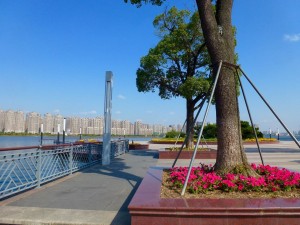 The lakeside park has been attractively landscaped
The lakeside park has been attractively landscaped
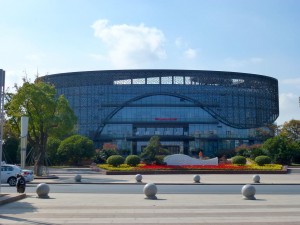 The neighbourhood sports and cultural centre looked quite impressive
The neighbourhood sports and cultural centre looked quite impressive
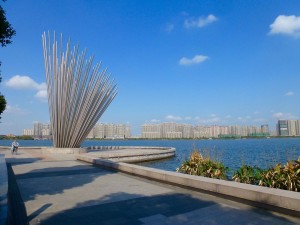 Chinese modern street architecture can be quite bold and striking
Chinese modern street architecture can be quite bold and striking
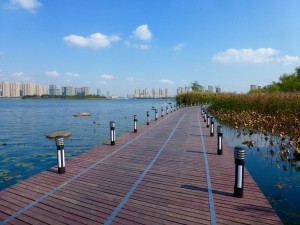 An attractive boardwalk led along the lake
An attractive boardwalk led along the lake
At one point, I was attracted to investigate a rather American-looking house close to the shore. It was strangely derelict, the slats falling off the side walls and the garden fence collapsing. But what was more interesting for me was that two or three largish butterflies were skimming around the tree-tops in its vicinity. These were Lesser Purple Emperors, Apatura ilia, a butterfly that I have seen a lot of since arriving in Suzhou, and one that I am very surprised should still be flying this late in the season. Flying they certainly were, and one point they were joined by a larger, more boldly striped butterfly, which I was not able to identify at all.
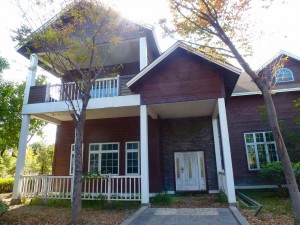 The strangely abandoned western-style house
The strangely abandoned western-style house
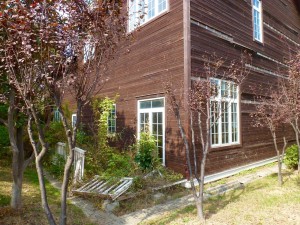 Planks were falling off the side wall and the garden fence had toppled over
Planks were falling off the side wall and the garden fence had toppled over
The Lesser Purple Emperors would not come down to be photographed, although I did manage to watch one female for a long period through my binoculars as she searched for a place to lay her eggs, feeling with her abdomen and occasionally pausing to lay. I had expected that the willows along the lake shore would be the chosen foodplant of this species, but this female was laying on what I think may have been the Chinese Hackberry, Celtis sinensis, a tree that plays host to many species of Nymphalid butterfly. In total I must have seen perhaps eight of these marvelous flyers.
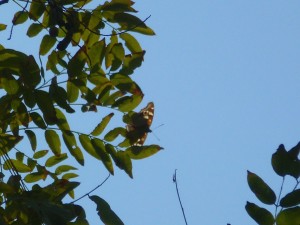 Please come down, Lesser Purple Emperor!
Please come down, Lesser Purple Emperor!
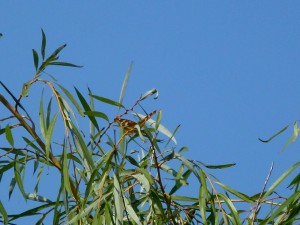 I can see you up there in that willow, Lesser Purple Emperor
I can see you up there in that willow, Lesser Purple Emperor
At one point, while I was scanning out across the lake in search of any further water birds, a couple approached me and asked if I would mind saying a few words in English to their nine-year-old son as he had never spoken English to a real foreigner before, so I obliged and then they asked if I would object to having my photograph taken with him, which I agreed to. In general, most Chinese I have come across so far have been friendly and helpful, and a surprising number of young ones, at least here in Suzhou, can speak at least a little English.
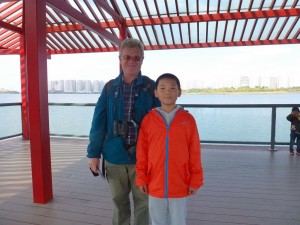 Chinese people like to pose for photographs with foreigners
Chinese people like to pose for photographs with foreigners
I paid special attention to patches of reed and lotus, as these seemed likely to harbour the most birds, but apart from several roving bands of the diminutive, long-tailed Vinous-throated Parrotbill and a small party of Black-faced Buntings, there was little to be found.
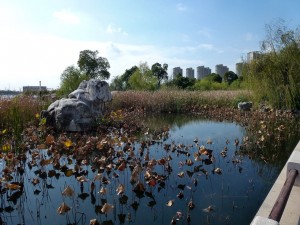 Patches of reed and lotus seemed likely to host some birds
Patches of reed and lotus seemed likely to host some birds
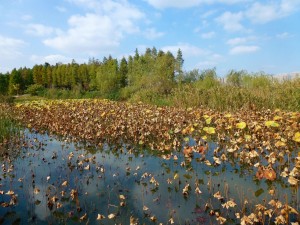 The lotus plants are dying back for the winter now
The lotus plants are dying back for the winter now
Groups of workers were busy clearing the reeds along the lakeshore, and I fear that within a few weeks there will be no reeds left until they re-grow next Spring. With such an abundance of cheap labour, China can afford to employ teams of gardeners to maintain the public areas, collecting litter (which I thoroughly applaud) and chopping vegetation (which I am less keen on, as it deprives wildlife of habitats and hiding places). Still, there were a number of butterflies around, and I enjoyed them as well as the beautiful autumn leaves as I continued my walk.
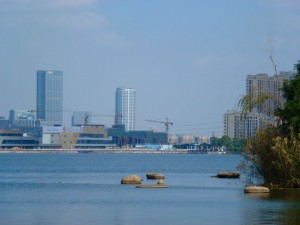 Moorhens and Little Grebes were here, as well as Great Crested Grebes further out
Moorhens and Little Grebes were here, as well as Great Crested Grebes further out
 I shall never tire of seeing these lovely Indian Fritillaries
I shall never tire of seeing these lovely Indian Fritillaries
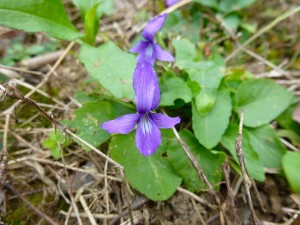 These unseasonal violets are the larval foodplant of the Indian Fritillary
These unseasonal violets are the larval foodplant of the Indian Fritillary
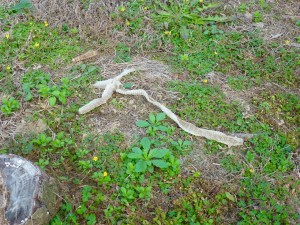 A cast snake skin served to remind me not to plunge too deeply into the bushes
A cast snake skin served to remind me not to plunge too deeply into the bushes
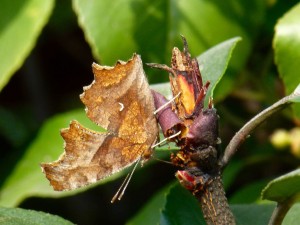 A Chinese Comma, showing the comma-shaped white mark on its underside
A Chinese Comma, showing the comma-shaped white mark on its underside
 A Small Copper always brightens any day
A Small Copper always brightens any day
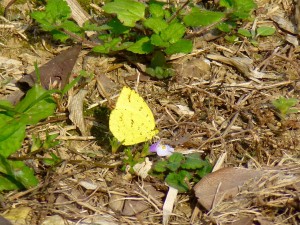 A Common Grass Yellow taking nectar in the sunshine
A Common Grass Yellow taking nectar in the sunshine
 A female Small White poses nicely
A female Small White poses nicely
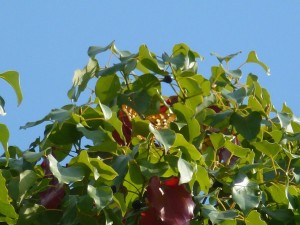 Still teasing me, you Lesser Purple Emperor!
Still teasing me, you Lesser Purple Emperor!
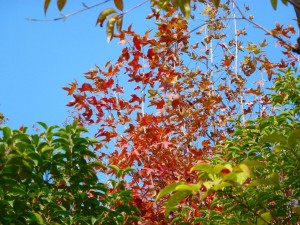 A reddening maple against the blue afternoon sky
A reddening maple against the blue afternoon sky
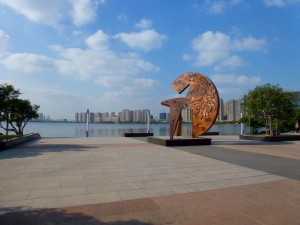 My last look at the lake before venturing back into the maelstrom
My last look at the lake before venturing back into the maelstrom
Eventually, I had completed my circumnavigation of the lake, and I ventured back into the vast building site, where I was approached by a smartly dressed young man on a motorbike, who asked me “You want see house?” I declined the offer, although perhaps I should have at least gone for a look, if only out of curiosity. Investing in one of these newly built areas might be worthwhile, although I believe it is hard for foreigners to own property in China, and I do not intend to settle here for very long…but at least a look might have been interesting.
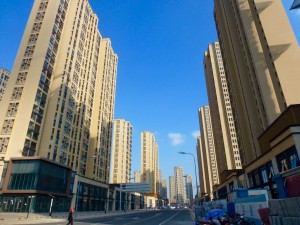 I was asked if I would like to visit a show flat in one of these buildings
I was asked if I would like to visit a show flat in one of these buildings
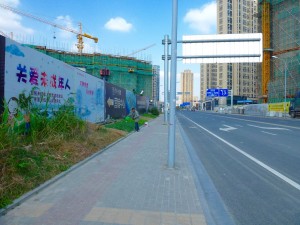 An enterprising "farmer" watering his vegetables next to this building site
An enterprising "farmer" watering his vegetables next to this building site


